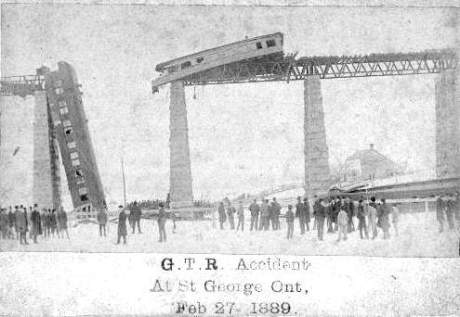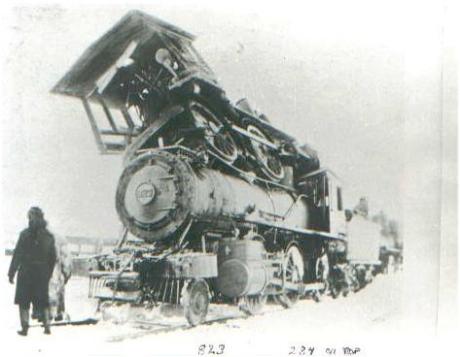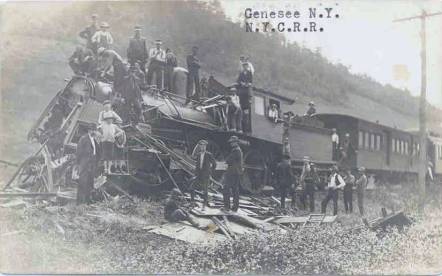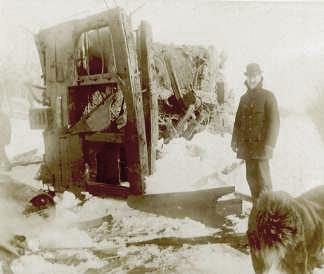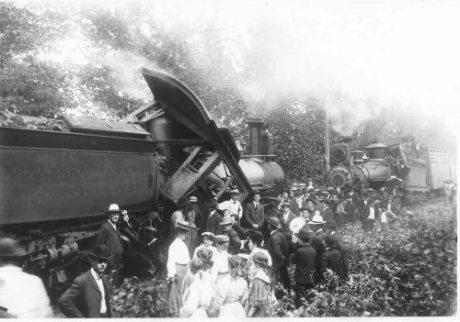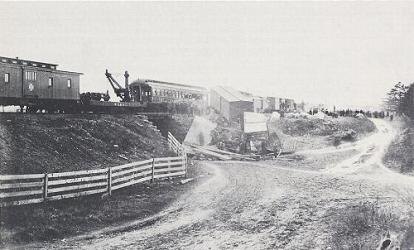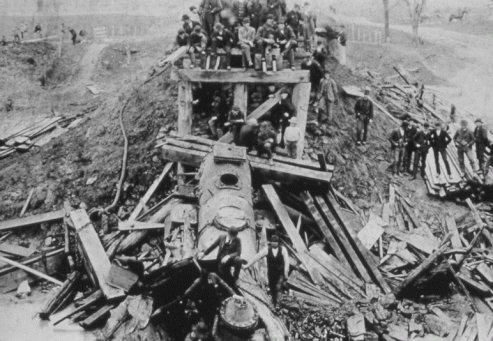Here is a video I found on a search for sick shit. Its a compilation of some hardcore wrecks, crazy crashes and just plain out stupid behavior. This comp has everything from racing crashes to train accidents to hardcore falls.
My favorite part of the entire video clip… Its gotta be the man in the office cubicle getting pissed at his computer and smashing the screen with his keyboard. That boy may need some anger management sessions.

Outrageous wrecks and hard falls – sick compilation video
Train wrecks and derailments of 2007
The Grayrigg derailment was a fatal railway accident that occurred at approximately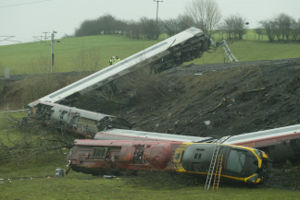 20:15 GMT on 23 February 2007, just to the south of Grayrigg, Cumbria, in north-west England. The initial conclusion of the accident investigation is that the derailment was caused by a faulty set of points , controlled from Lambrigg ground frame. The scheduled inspection on 18 February did not take place, and enquiries are continuing to establish why the faults were undetected
20:15 GMT on 23 February 2007, just to the south of Grayrigg, Cumbria, in north-west England. The initial conclusion of the accident investigation is that the derailment was caused by a faulty set of points , controlled from Lambrigg ground frame. The scheduled inspection on 18 February did not take place, and enquiries are continuing to establish why the faults were undetected
Train 1S83, the 17:15 Virgin West Coast Pendolino West Coast Main Line service from London Euston to Glasgow Central, a limited stop Pendolino Primo train, was derailed by a defective set of points.[2] The train was reported to have been travelling at up to 95 mph (150 km/h) when it was derailed.[1] The train, consisting of unit 390 033 “City of Glasgow”, which was constructed at Washwood Heath, Birmingham in 2002, had nine carriages and carried 111 passengers and four members of staff.[3]
Passengers said that the carriages of the train began rocking and swaying very badly before the train crashed. The train was reported as being evacuated at around midnight. Emergency crews scanned the train with thermal imagery equipment to make sure there was no one still inside. Up to 500 rescuers attended the scene, and at least 12 ambulances and at least five fire engines, three Royal Air Force Sea King helicopters, three civilian mountain rescue teams plus RAF Leeming Mountain Rescue Team, and one Merseyside Police helicopter. The rescue operation was impeded by rain, darkness, and access problems because access was narrow country lanes and then across muddy fields. Emergency vehicles experienced difficult conditions, needing to be towed by farm vehicles or tractors after becoming bogged down in mud.
Cumbria Ambulance Service initially reported that the train was six carriages long and that the second carriage had slipped down an embankment, with the carriage trapping up to eight people. Later, a BBC News reporter at the scene reported that all but one carriage had been overturned.
Live BBC TV coverage at 08:15 next morning showed that although the whole train had been derailed, the rear carriages still standing nearly vertical on the sleepers and ballast. Standard class, the front five carriages, was the worst affected, and with four rear First Class carriages was least affected. The leading carriage, a driving motor coach, had headed down the embankment, and turned end-for-end as it fell. It was lying on its side at the foot of the embankment. The second carriage had jack-knifed against the first, breaking the coupling, and so had not followed it down the bank. This second carriage came to rest some distance further along the track, at a steep angle with one end in the air. The middle part of the train toppled sideways down the embankment. All the carriages stayed structurally intact, with damage mainly confined to the crumple zones at their ends. Most injuries occurred in the front two carriages. The driver, who had stayed at the controls, was trapped for around an hour while specialist cutting equipment was used to free him from his cab.
The other three of the four train crew were in the rear First Class section of the train.
The area near the accident, south of Tebay in Cumbria, is near the scene of a fatal rail accident on 15 February 2004, when four rail workers were killed by a runaway track maintenance trailer.There was also a collision accident there on 18 May 1947
accident on 15 February 2004, when four rail workers were killed by a runaway track maintenance trailer.There was also a collision accident there on 18 May 1947
Date and time: 23 February 2007, 20:15 GMT
Location: Grayrigg, near Kendal, Cumbria
Rail line: West Coast Main Line
Cause Condition of points
Passengers: 111
Deaths: 1
Injuries: 22
2007 Kerang train crash
From Wikipedia
 |
|
| Date and time: | 5 June 2007 |
|---|---|
| Location: | Kerang, Victoria |
| Cause | Level crossing collision |
| Statistics | |
| Trains: | 1 |
| Passengers: | 36 |
| Deaths: | 11 |
| Injuries: | 23 |
on 5 June 2007 at about 1:40 pm AEST in the Australian state of Victoria, approximately 6 kilometres (3.7 mi) north of the town of Kerang in the state’s northwest, and about 285 kilometres (177 mi) northwest of the city of Melbourne. V/Line passenger train service 8042 which consisted of locomotive N460 and carriage set N7 and a northbound semi-trailer truck collided at a level crossing where the Swan Hill railway line crosses the Murray Valley Highway. Victoria Police confirmed that 11 people were killed and 23 injured in the crash. As of 11:00 am on the 6th of June, two passengers remained unaccounted for.The site was visited on the evening of 5 June by the Premier of Victoria, Steve Bracks, who called it a “horrific scene”
The train involved in the accident was a locomotive-hauled service from Swan Hill that departed for Melbourne at 1:00pm. The collision caused the closure of nearby sections of the Murray Valley Highway
fatal railway accident that occurred shortly after 02:00 local time on 19 December 2007 near the town of Mehrabpur in the Sindh province of Pakistan.
The train was an express service from Karachi to Lahore, and was packed with passengers returning home for the Eid ul-Adha Islamic holiday. At around 2:25 a.m. local time, fourteen of the train’s sixteen carriages left the tracks, some being mangled by the crash, others simply sliding down an embankment into the water.
Sabotage and terrorism were ruled out as the reason for the crash, with officials believing a faulty track was the cause of the derailment. The death toll was initially estimated as at least 56 people, but Junaid Qureshi, director of operations for the state-run Pakistan Railways, later lowered the official estimate to 40 deaths and 269 injuries.
Among local people and those who were traveling through accident area, opinions about the number of deceased is much higher, estimated between 400 and 800 dead (with an average of around 500) and over a thousand injured. This is based upon the fact that 14 bogies were almost completely wrecked, and only two of the carriages were left more or less intact, with others being severely damaged.
Given that the accident took place in the holiday period, practically all the seats and sleepers were occupied, bringing the number of people in one carriage close to 80, therefore justifying higher estimation.
Old time train wrecks and derailments
Here are pictures of some historical train wrecks in black and white. These are from the turn of the century and look pretty sick

Some more Black and white old time train wrecks, this one took out the bridge


1889 train accident on a bridge
Marlborough Junc Mass on the New Haven dated Feb 4th 1898. The collision happened on the Clinton and Fitchborough branch. A milk train hauled by 4-4-0 #234 hit head on with a snowplough pushed by two locos (one of which was 823). The 4-4-0 rode up the sloping snowplough blade and perched on the boiler of 823
Northern Pacific rotary February 11, 1903
On February 10, 1903, betwen Saltese, Montana, and Wallace, Idaho, one Northern Pacific rotary met the full onslaught of the winter snows. A breakdown had trapped them in the deep snow and the crew worked by hand to dig out the train. Inching their way along the tracks in the middle of the night, they halted the train at the “S” Bridge, an 839 foot sinuous trestle on the Coeur d’ Alene branch about 7 miles from Mullan ID, that offered them respite while the snow accumulated in the gulch. A pusher engine and a caboose were left in the open while the remainder rested on solid ground. At seven in the morning a massive snowslide raced down the gulch and ripped out a portion of the bridge. The rear engine and the caboose plunged into the gorge, burying the engine in the deep snow while the caboose and its seven sleeping occupants lay shattered on top. A passenger car, with eight aboard, hung off the end of the broken trestle, dangling from the coupler. Although no-one was killed, it took doctors eleven hours to get the shocked and dazed survivors to the hospital at Wallace.
<
This turn of the century train derailment happened when the train got snowed in, stopped along a bridge, and the bridge got washed away by snow as the train was on it… talk about bad luck

Marlborough train wreck, another pick of the train accident from above
1903 train derails, this looks like one sick accident
to see the rest of the old time train wreck and derailment pictures… just click here
train wrecks from the old times – train wreck history
Some Great and Historic early Train Wrecks
Numerous train wrecks occurred during the Housatonic Railroad’s 91 years of operation. Passengers were always at risk of accidents that infrequently occurred. Since the line was on a single lane of tracks, most of the serious accidents were head-on collisions. The picture of the train wreck shown here was captioned “Housatonic RR Wreck in Long Hill 1889.” In an 1865 wreck, eleven persons died and another 27 were injured when a passenger train heading to Pittsfield Massachusetts came upon a disabled freight just North of Trumbull Center. The engineer then decided to back the train back to the Bridgeport depot when it collided with
locomotive “Fairfield” on its first trial run. This normally unscheduled train had departed the Bridgeport depot only fifteen minutes after the Pittsfield bound passenger train. In 1881, a Parlor Rock excursion train from New Milford ran head on into a milk train just North of Parlor Rock. Fortunately, this accident occurred on a rainy day and the excursion train was not carrying many passengers. Only the excursion train’s engineer was instantly killed when the two trains collided. In 1899, an accident North of the Beers Mill station resulted in two deaths. In 1901 a freight train running from Halleyville to Bridgeport met head on with a North bound freight train heading for Great Barrington, Massachusetts. The two trains collided about 1000 feet South of the Beers Mill station, resulting in the deaths of five people. The engineer of the South bound freight survived but lost his arm in the accident. He admitted to have been the cause of the accident when he fell asleep and failed to pull off at the Stepney siding and wait for the North bound freight to pass.
 The first accident recorded is that of John Hamann, who was killed prior to 1876, while riding his wagon across the railroad. Charles E. Van Pelt, a brakeman on the Union Pacific, was killed near Shelton, in November, 1876. During the work of repairing the railroad bridge over the Platte, in March, 1884, some timbers gave way and engine, derrick and pile-driver fell into the river. James Dennon was killed and two men injured. Eleven of the 180 horses belonging to Palmer & Talmage, which broke through the corral just north of the city, in September, 1885, were killed by the Denver Union Pacific train, and several animals injured.
The first accident recorded is that of John Hamann, who was killed prior to 1876, while riding his wagon across the railroad. Charles E. Van Pelt, a brakeman on the Union Pacific, was killed near Shelton, in November, 1876. During the work of repairing the railroad bridge over the Platte, in March, 1884, some timbers gave way and engine, derrick and pile-driver fell into the river. James Dennon was killed and two men injured. Eleven of the 180 horses belonging to Palmer & Talmage, which broke through the corral just north of the city, in September, 1885, were killed by the Denver Union Pacific train, and several animals injured.
John C. W. Longnecker, of Steelton, Pa., was killed by a St. Joseph & Grand Island train, in September, 1885.
Dick Hughes and George Donaldson, brakemen on this road, were killed in November.
D. B. Thompson, of the Union Pacific, was killed March 27, 1886.
The Union Pacific passenger, No. 1, was wrecked at Grand Island in September, 1886. An unknown man was run over and killed by a Union Pacific locomotive (No. 743) at the coal house, April 7, 1887. Other deaths on the rail are referred to, but the dates have not been ascertained. Trains have been ditched in many instances, and snow-bound inside the lines of this county more than once.
During the early, foggy morning hours of December 4th 1891 four trains would meet in East Thompson, Connecticut with disastrous consequences. No one could have known earlier that morning that they were all destined to go down in history in what would later be known as The Great East Thompson Train Wreck. This spectacular crash of four trains, is the only train wreck of its’ kind in the history of railroading in the United States.


